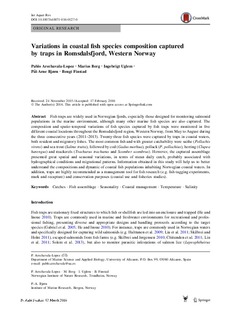Variations in coastal fish species composition captured by traps in Romsdalsfjord, Western Norway
Peer reviewed, Journal article
Permanent lenke
http://hdl.handle.net/11250/2383087Utgivelsesdato
2016Metadata
Vis full innførselSamlinger
- Publikasjoner fra CRIStin - NINA [2364]
- Scientific publications [1392]
Sammendrag
Fish traps are widely used in Norwegian fjords, especially those designed for monitoring salmonid
populations in the marine environment, although many other marine fish species are also captured. The
composition and spatio-temporal variations of fish species captured by fish traps were monitored in five
different coastal locations throughout the Romsdalsfjord region, Western Norway, from May to August during
the three consecutive years (2011–2013). Twenty-three fish species were captured by traps in coastal waters,
both resident and migratory fishes. The most common fish and with greater catchability were saithe (Pollachis
virens) and sea trout (Salmo trutta), followed by cod (Gadus morhua), pollack (P. pollachius), herring (Clupea
harengus) and mackerels (Trachurus trachurus and Scomber scombrus). However, the captured assemblage
presented great spatial and seasonal variations, in terms of mean daily catch, probably associated with
hydrographical conditions and migrational patterns. Information obtained in this study will help us to better
understand the compositions and dynamic of coastal fish populations inhabiting Norwegian coastal waters. In
addition, traps are highly recommended as a management tool for fish research (e.g. fish-tagging experiments,
mark and recapture) and conservation purposes (coastal use and fisheries studies).

